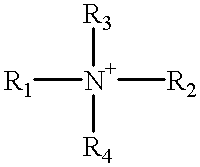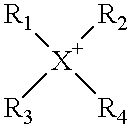Intercalates formed via coupling agent-reaction and onium ion-intercalation pre-treatment of layered material for polymer intercalation
a technology of coupling agent and intercalation pretreatment, which is applied in the field of intercalates formed via coupling agent reaction and onium ion intercalation pretreatment of layered materials for polymer intercalation, can solve the problems of difficult intercalation of non-polar and low-polar oligomers and polymers, and achieves excellent intercalation dispersibility, easy co-intercalation, and easy intercalation of oligomers or polymers
- Summary
- Abstract
- Description
- Claims
- Application Information
AI Technical Summary
Benefits of technology
Problems solved by technology
Method used
Image
Examples
example 1
Example 1 demonstrates the formation of silane-treated Nanomer A 137-ODA-CWC.
One hundred grams of Na-montmorillonite clay (PGW) commercially available from Nanocor, Inc. (Arlington Heights, Ill.) was dispersed in 3 liters of de-ionized water by mechanical paddle mixer or colloidal mill. The clay dispersion was heated to 75.about.80.degree. C. 37.8 g of Octadecyl-amine, available from Akzo Nobel, was mixed with 70 ml 2 N HCl in 1 liter 75.about.80.degree. C. de-ionized water. The amine-HCl solution was introduced into the clay dispersion, followed by vigorous mixing. The mixture was adjusted to pH 3.about.4 by acetic acid, and maintained at 75.about.80.degree. C. for about 30 minutes. After thorough washing with de-ionized water, the Octadecyl-ammonium treated sodium montmorillonite clay was collected by filtration. The filter cake was re-dispersed into 3 liters of 75.about.80.degree. C. water.
In a separate container, 2 g Octyltriethoxysilane (A 137) was dissolved in 40 g 9:1 (w / w) b...
example 2
The procedure of Example 1 was repeated to produce a silane-treated organoclay except that Octyltriethoxysilane was replaced by 3-aminopropyltriethoxysilane (A1100). The dried material has a d001 of 22 .ANG. as measured by X-ray diffraction and was coded as A1100-ODA-CWC.
example 3
Example 3 demonstrates the formation and properties of a polypropylene (PP) nanocomposite with a silane-treated and onium ion-treated nanomer through a direct melt compounding method.
Six parts of A1100-ODA-CWC was incorporated into 92 parts of polypropylene and 2 parts of maleic anhydride-modified polypropylene (MAPP) using a twin screw extruder at 180-190.degree. C. The presence of MAPP will help to improve the adhesion between the organo-clay and the polypropylene matrix polymer. The resulting pellets were injection molded into the testing bars. X-ray diffraction shows the treated clay has a well ordered intercalation structure with a d001 of 29 .ANG.. Physical properties of the thus-formed specimens were measured, and the results are shown in Table 1.
PUM
| Property | Measurement | Unit |
|---|---|---|
| weight percent | aaaaa | aaaaa |
| weight percent | aaaaa | aaaaa |
| weight percent | aaaaa | aaaaa |
Abstract
Description
Claims
Application Information
 Login to View More
Login to View More - R&D
- Intellectual Property
- Life Sciences
- Materials
- Tech Scout
- Unparalleled Data Quality
- Higher Quality Content
- 60% Fewer Hallucinations
Browse by: Latest US Patents, China's latest patents, Technical Efficacy Thesaurus, Application Domain, Technology Topic, Popular Technical Reports.
© 2025 PatSnap. All rights reserved.Legal|Privacy policy|Modern Slavery Act Transparency Statement|Sitemap|About US| Contact US: help@patsnap.com



